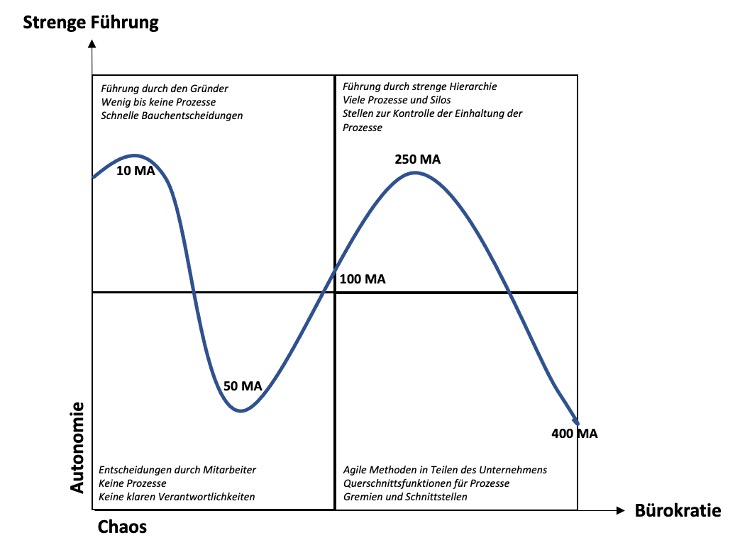Companies grow year after year – German SMEs and medium-sized companies in particular can do one thing best: grow! It is precisely this growth that offers employees great opportunities, such as management positions or other rather special career paths such as lateral entrances. It was precisely these opportunities that made me enthusiastic about SMEs and so far I have only worked in SMEs. I saw a lot of growth there and was always happy to be part of this company and to contribute to its growth.
But I also noticed that companies can break down when they grow. “The numbers are great, but it is no longer so exciting to work there.”, Employees told me. I noticed that different crises can arise depending on the growth. In this article I will show you what these are and how an SME can cope with them.
Tip: The model is based on the ideas of the Greiner models . However, this was too easy for me and important aspects are missing. Which is why I designed my own model.

Limitation: This is a model from my experience. It should simply represent reality and serve as a guide. It can also be that every company is a little different. I would like to provide orientation with this model. It has not been scientifically proven but reflects my experiences.
Excursus: What are SMEs
KMU stands for small and medium-sized companies. It includes 99.3 percent of all German companies (3.5 million). It is divided into:
- Small business (up to 9 employees)
- Small companies (up to 49 employees)
- Medium-sized companies (up to 249 employees)
- Large companies (from 250 employees or often from 500 employees)
Most businesses – almost 85% are small businesses. I myself have based myself on the definition from my research and also from my professional life as a management consultant, but have also added my own threshold values. I will explain these values at the appropriate places in the course of the article.
Small and strong (10 employees)
The company is still small and not that old. Everyone knows each other – the official channels are short. We talk a lot with each other. What strikes me in particular is that everyone does everything – the employees are very versatile.
The first crisis starts with 10 employees or more. The founders are busy managing the new employees, so strategic planning falls by the wayside. There is a leadership crisis because it is no longer possible to discuss everything personally. This phase is pretty easy. It is enough to give the employees more freedom and possibly to define rather loose roles.
Management crisis (50 employees)
The company demonstrated its strength primarily through creativity and the high level of commitment of the first employees. Everyone learned and does everything. The main thing is that the customer is satisfied. Decisions are mainly made by the founders and there is creative chaos in many places.
This is exactly where the first crisis starts. Here it is important for the founders to let go. The highly dynamic interaction reaches its first limits from 10 employees and can still be maintained up to 50 with the first team leaders (professional leadership). The need to set up initial structures and managers is becoming apparent, since everything can no longer be done on the founders’ desks alone. A management team and 2-3 disciplinary leaders are required. This includes not only all technical aspects but also “soft” topics relating to the qualification, development and support of employees.
In this phase it is up to the founders to let go and build management structures. Much interaction is required with the founders. The founders can no longer process all the information. Some employees, who can no longer clarify everything with the founders, will also feel uncomfortable and one or the other will certainly go back to a small company.
Cultural crisis (100 employees)
It changes slowly but continuously. The biggest change is that not everyone does everything – everyone has their own special field. New employees are being sought for special tasks and there are first internal teams such as controlling and HR.
Due to the specialization of the individual employees, everyone still knows each other, but the information must be given along a chain after the first processes. This is the phase in which the company changes most noticeably:
- There is a struggle in the company between the new employees and the old long-term employees. You will no longer find your company and its culture shaped by founders as they did in the past. There is a lot of talk about the past.
- Due to the new specialization, there are not yet enough strengths for everything – the consequence with internal tasks: Nobody feels responsible anymore. The company becomes slow and inflexible.
Competition has arisen between the two cultures. The uniformity towards the customer is lost. Processes are defined, but there is wild growth. It is now important for the founders to employ good managers who convey and represent the company’s processes and values.
In this phase, companies easily lose agility as they have reached critical mass. There is also the risk here that the company will break apart in the middle due to the cultural dispute. Often, external service providers are also added during the phase to advise on the development of the organization. It is important to change the culture of the company in a targeted manner and to preserve traditions.
Bureaucratization (250 employees)
The first complete areas of responsibility have now been structured. The consequence is departments or regional responsibilities. Profit centers, business areas and the first cross-sectional functions, such as internal process management, are formed. Due to the internal chaos, more and more processes and structures are being built. Everyone optimizes their area and there is always talk of interfaces.
Here, companies notice that, despite increasing sales, profits are falling somewhat. More formal planning is used and new employees are hired for overall coordination. Certain functions are also controlled centrally and you have to turn to an often overloaded point that often does not deliver in time.
Often, however, the limit of what is necessary is exceeded. The company is starting to get caught up in its own bureaucracy. Structures are firmly specified by the board, processes are clearly defined and compliance is monitored. To this end, an internal department drafts instructions, checklists and reporting templates. The leadership also takes some decisions back to itself. Uniformity is demanded again.
The only problem is that standardized processes make the company immobile and a task is often discussed longer than it is done. Decisions are often based more on guidelines and principles than on customer benefit. Many companies lose many employees at this threshold.
However, the market demands quick decisions and employees are quickly frustrated. Of course, some form of bureaucracy is necessary, but the company only has 250 employees and not 5000. The task now is to break open the rigid organization using agile methods.
Silo crisis (400 employees)
Now strong departments have been established and slowly the bureaucracy is being dissolved and more freedom is given. The challenge now is that the new departments, areas and business areas continue to work in the interests of the company and not create closed silos. But especially after the reduction in bureaucracy, some employees are strongly opposed to it.
Competition has arisen between the departments. Uniformity towards the customer is lost and power struggles begin. In this phase, the founder is challenged. He now has to tear down rigid silos and small kingdoms that some department heads have built up hard over the years. This is followed by the dissolution of the silos and mixing according to cross-functional departments according to agile methods. Unfortunately, some executives also have to be removed during this phase and, in my experience, they are often long-term friends of the founder.
If this change does not take place, the company becomes more and more bureaucratic and rigid until the department heads have such a high degree of autonomy that there are so strong silos that are no longer controllable by the founder. It is no longer clear who is doing what exactly, as the department heads have sometimes created a strong lack of transparency to the outside world.
In this phase, soft skills such as social control, empathy and self-discipline, which replace the formal processes, are particularly important. The solution is problem-solving, interdisciplinary teams, open meetings with all those responsible and skills. Compensation models for entire groups are also good, rather than just an entire bonus. This change is particularly difficult for everyone who helped set up the formal processes.
Conclusion
Growing an SME is not easy and there are many phases. As a founder you have to constantly change and experience many phases as an employee. Every employee has a form where he feels most comfortable, e.g. I know many who only work in the autonomy and chaos sector and who always leave companies of 100 or more people.
For a better summary, I have visualized the phases again and structured them according to leadership and bureaucracy. Sure: not every company goes through the phases like this, but there is a clear tendency to recognize that I think most SMEs feel that way. Take the picture as a guide and classify your SME there.




